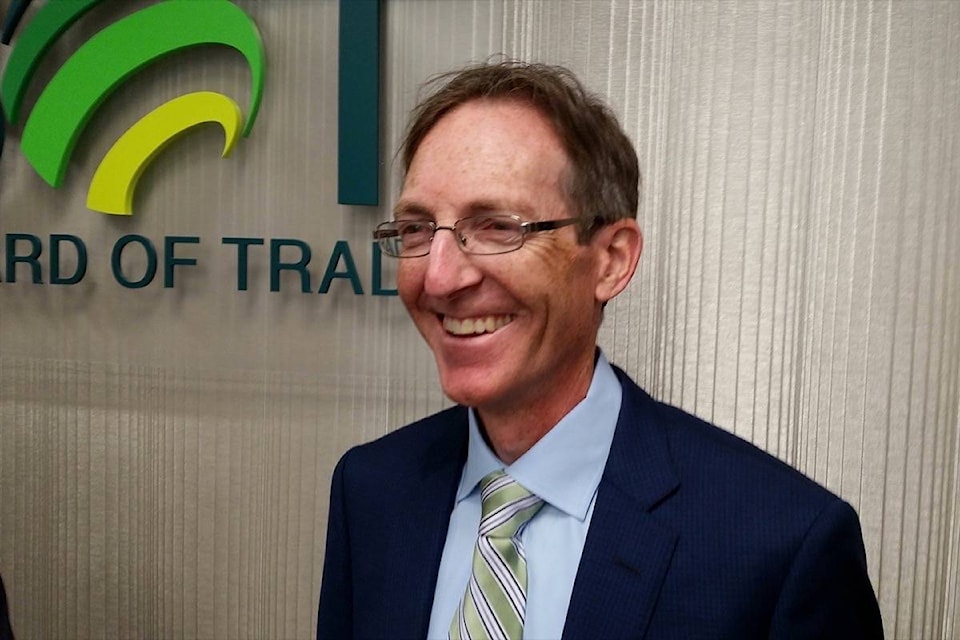The president of ICBC says two-thirds of drivers will be “better off” than they are today with proposed auto insurance changes expected to take effect in September 2019. But if you want to know how these changes are going to affect you personally, he says, you’re going to have to wait.
ICBC’s president and CEO Nicolas Jimenez spoke to the corporation’s priorities for insurance changes and their impacts on businesses Wednesday morning during a “round table discussion” at the Surrey Board of Trade office in Whalley.
The corporation, he said, has an application before the utilities commission designed to “improve and fundamentally make more fair the way we’re treating the insurance rating, bringing major change to a rating scheme that we think will work better for a majority of British Columbians.”
“I think the biggest change is absolutely making sure we bring more accountability into the system. Currently today we think too many high-risk drivers don’t pay their share of insurance and we think conversely low-risk drivers are paying too much.”
ICBC president and CEO Nicolas Jimenez in Surrey today to discuss insurance changes and impacts with the board of trade. #surreybc pic.twitter.com/XjKSwo4N8l
— Surrey Now-Leader (@SurreyNowLeader) September 5, 2018
“In the future we’re going to see in the scheme based on a driver-based model,” Jimenez said. “So today, drivers can escape accountability; the crashes are attached to the individual. In the future, crashes are going to be attached to an individual — I caused that crash, I own that crash, and that’s a really important change.”
Jimenez said the changes propose to extend the amount of discounts to drivers, which currently max out at 43 per cent after nine years. “In the future, you’re going to have up to 40 years to accumulate more discounts, and those discounts are going to increase to up to 52 per cent. We think that’s great for drivers.”
He said ICBC has a “big job” ahead of it to communicate the proposed changes to the public before September 2019. “So between now and then we’re going to see a lot of communication activities targeting not just customers but also our brokers.”
Jimenez said ICBC will be introducing a 10 per cent discount on basic insurance for people who drive less than 5,000 kilometres. “We know distance is directly related to risk and if you’re not driving your vehicle a substantial amount you are inherently bringing less risk to the road. It’s only one discount — we’re still looking at crash history and other features, but distance is something that we think will really benefit a lot of British Columbians.”
“This rate design is designed to improve things for two-thirds of drivers, so two-thirds of drivers will be better off in this rate design than they are today,” he said. “What we won’t know specifically is the individual impact on someone’s premium next year. In December of this year we’re going forward with an application with the utilities commission and we’ll be putting forward our rate need for next year, and at that time people will be able to have a conversation about well how will impact me specifically.”
READ ALSO: ICBC moves to tighten driver discount rules
Meantime, ICBC and police are expected to launch on Thursday a campaign against distracted driving, specifically targeting drivers who use their phone while stopped at a red light. According to ICBC, there are roughly 960 crashes in B.C. every day, many of which are caused by distracted drivers.
Jimenez noted that 140 red light cameras have been activated 24/7 in B.C.
Lindsay Matthews, ICBC vice president of communications, said “over a million excessive speeders” passed through intersection safety cameras over a two-year period. “So intersections are a very dangerous place.”
The cameras and other initiatives, she said, “are really going to supplement traditional law enforcement tools.”
“Law enforcement is challenged to make sure they can keep up with the growth as well,” Matthews said.
The provincial government is also applying a “high-friction surface treatment” to 14 high-collision locations in the Lower Mainland and on Vancouver Island, to help drivers stop faster. The idea is to reduce rear-end collisions.
This will include four interchange off-ramps and 10 intersections.
Two of the locations are in Surrey, at the intersection of Highway 10 and 176th Street eastbound and westbound, as well as the intersection of Highway 10 and Scott Road, eastbound and westbound.
tom.zytaruk@surreynowleader.com
Like us on Facebook Follow us on Instagram and follow Tom on Twitter
